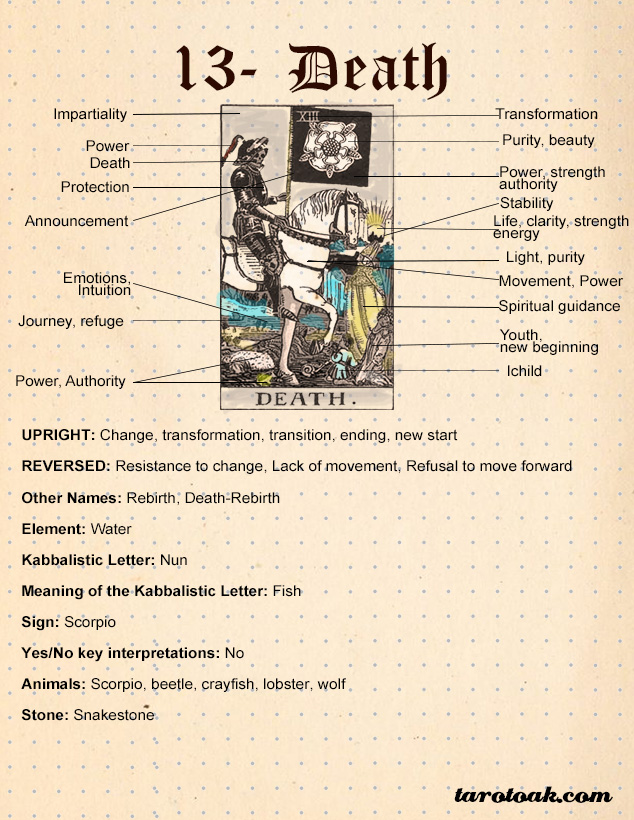The Death tarot card, often met with trepidation and misunderstanding, serves as a potent emblem of transformation and renewal, particularly within the realm of love. Its symbolism transcends the mere connotation of physical demise; instead, it heralds the conclusion of a cycle, making way for new beginnings. In love readings, the Death card invites us to shed outdated relationships, unresolved emotional baggage, and essential fears, ultimately leading to rejuvenation and liberation. In this exploration, we delve into the intricate tapestry of the Death tarot card meaning as it pertains to love, illuminating its multifaceted significance.
At first glance, the imagery of the Death card—typically depicting a skeletal figure arrayed in a dark, flowing cloak—might transmit feelings of dread. However, this figure, often accompanied by symbols such as a rising sun or flowers, underscores the cycle of life and death that mirrors nature’s rhythms. Love, too, is subject to these cycles, where endings are invariably intertwined with new beginnings. Just as the earth sheds its burdensome layers during autumn to reawaken in spring, individuals must sometimes relinquish old attachments to embrace new emotional landscapes.
When the Death card emerges in a love reading, it may signify the culmination of a relationship. This ending is often fraught with emotional intensity. However, the emphasis is not solely on loss; rather, it is an invitation—a clarion call to engage in introspection. Are the foundations of your relationship frayed? Is stagnation enveloping the love that once flourished? The presence of the Death card urges individuals to confront these uncomfortable truths. It serves as a catalyst, encouraging them to dismantle relationships that no longer serve their higher selves, thereby allowing for healing and growth.
This transformative aspect of the Death card becomes particularly poignant when considering its implications for personal evolution. Relationships are mirrors, reflecting our deepest insecurities and desires. In this context, the dissolution of a partnership may illuminate the need for self-discovery and authenticity. The end of a union can prompt individuals to reconnect with their intrinsic values, desires, and ambitions. It establishes a fertile ground where new love can germinate—one that resonates more closely with the individual’s true essence.
For those who are navigating the profound waters of a breakup, the Death card’s energy encourages acceptance of grief as a necessary aspect of change. It is essential to honor the emotions that arise during these transitions. Mourning the end of a significant relationship allows individuals to process their feelings, fostering a sense of closure. The Death card symbolizes that through this phase of sorrow and reflection, one may ultimately emerge revitalized—a phoenix rising from the ashes, prepared to embrace love anew with wisdom gained through experience.
Embracing change also encompasses discovering love that affirms rather than diminishes one’s self-worth. When the Death card embodies the end of a toxic or unfulfilling relationship, it signifies liberation from emotional constraints. The card challenges individuals to explore avenues of self-love. By prioritizing personal growth, one develops the capacity to attract relationships that respect and celebrate their individuality. Such enlightenment empowers them to choose partners who align with their evolving aspirations, ushering in a profound sense of connection and fulfillment.
Conversely, the Death card does not solely symbolize the end; it can herald significant transformations within ongoing relationships. If two individuals are committed but find themselves ensnared in patterns of repetitive conflict or discord, the Death card can signal an impending metamorphosis. This transformation may exemplify a renewed commitment to communication, vulnerability, and understanding. It wields the potential for couples to rediscover one another, shedding the burdensome expectations that have obfuscated their connection.
Moreover, the Death card is an invitation to abandon the fear of abandonment and vulnerability. In love, one must be willing to open oneself to the full spectrum of emotions. Often, it is through vulnerability that the most profound connections emerge. By confronting fears associated with love’s transient nature, individuals can cultivate a deeper, more authentic form of connection. The transformative energy of the Death card can facilitate this shift, allowing individuals to embrace love that is both transformative and enduring.
In scenarios where the Death card appears heralding growth within a relationship, it emphasizes the importance of fostering an atmosphere conducive to introspection and dialogue. It encourages partners to ask themselves: What changes are necessary for us to thrive? Are we nurturing each other’s growth? This reflective process can result in commitments that breathe new life into a relationship, forging a bond that is dynamic rather than static.
Ultimately, the Death tarot card in the context of love serves as a profound reminder that endings and beginnings are not opposites but rather integral components of the same cycle. It cultivates awareness of the impermanence inherent in all relationships, urging individuals to embrace change without fear. This card extols the virtue of courage—encouraging us to let go of the familiar, to venture into the unknown, and to trust that new love, in whatever form it may assume, awaits on the horizon.
As you navigate the intricate dance of love, remember that the essence of the Death card lies in its promise of renewal. Just as nature endures cycles of birth and decay, so too do our hearts and relationships. By understanding and accepting the Death card’s message, individuals can unlock realms of possibility, discovering love that is not just an echo of the past but a thriving and evolving journey into the future.









Leave a Comment